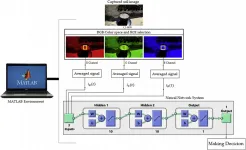(Press-News.org) COLUMBUS, Ohio - An analysis of historic and projected simulations from 19 global climate models shows that, because of climate change, the temperature in the Antarctic peninsula will increase by 0.5 to 1.5 degrees Celsius by 2044.
The projections also showed that precipitation - a threat to ice if it manifests as rain - will likely increase on the peninsula by about 5% to 10% over that same time period.
The estimates were published recently in the journal Climate Dynamics.
"We are concerned about these findings. We've been seeing overall quite big changes on the peninsula, generally getting warmer and ice shelves and glaciers discharging into the ocean," said David Bromwich, a leading author of the study and a research professor at The Ohio State University Byrd Polar and Climate Research Center and department of geography.
The peninsula sticks up like a tail off the northwest side of Antarctica, curving near the southernmost part of South America and Chile.
Since the 1950s, the peninsula, along with the rest of the western part of Antarctica, has been one of the fastest-warming regions on Earth. And because it is covered in mountains - the highest peak is just over 10,600 feet - standard climate models overlook some of the nuances of how climate change affects the peninsula, Bromwich said.
"The issue for the Antarctic peninsula is that it's this narrow but high mountain range, and these big models spanning the whole continent don't take that into account. Our goal was to provide more detail in those projections," he said.
The analysis found that the greatest increases in temperature - about 2 degrees Celsius - were likely to happen in the Antarctic fall and winter, but warmer temperatures projected for summer would cause the most trouble.
That could create a double threat to the ice on the peninsula, Bromwich said: Warmer temperatures also mean that some precipitation that might have previously fallen as snow will likely fall as rain.
More rain means less snow on top of the ice, which protects ice from the sun's rays by reflecting them back into the sky.
"But now, if you have bare ice, or ice that's a little bit melting, and the sun beats down on it, a good fraction of that energy goes into melting," Bromwich said. "And we've seen this in the past with other ice shelves - it's like a hammer, it just shatters."
The study's authors also found that, to truly predict what might happen on the peninsula, better, more nuanced climate models are needed.
Big climate models - those that cover the surface of the Earth - often do not consider other factors specific to smaller regions. In the Antarctic peninsula, Bromwich said, an overlooked factor is the modification of the westerlies, winds that blow from west to east near either pole. The westerlies blow directly over the Antarctic peninsula, creating a sort of micro-climate that big climate models often miss.
Those nuances are especially important in the Antarctic peninsula, which has since the late 1970s been considered an important vanguard of what might happen throughout the rest of Antarctica. The peninsula, climate scientists have come to understand, is more susceptible to the effects of climate change. The first person to predict that changes throughout Antarctica would first be seen on the peninsula was another Ohio State researcher, John Mercer, who was known around the world for his work on climate change in Antarctica.
INFORMATION:
CONTACT:
David Bromwich,
bromwich.1@osu.edu
Written by Laura Arenschield,
arenschield.2@osu.edu
PROVIDENCE, R.I. [Brown University] -- Proposals to create a national gun registry have long been met with fierce opposition from gun rights advocates. While proponents say a registry would help in tracking guns used in crimes, opponents worry that it would compromise privacy and could be used by the federal government to confiscate firearms. Now, a team of Brown University computer scientists has devised a way of implementing a registry that may allay some of those concerns.
They propose a database that uses advanced encryption to protect privacy. The encryption scheme allows the database to be searched without being decrypted, which means people querying the database see only the records they're looking for and nothing else. Meanwhile, the system places control of data ...
Lemurs can use their sense of smell to locate fruit hidden more than 50 feet away in the forest--but only when the wind blows the fruit's aroma toward them, according to a study published in the American Journal of Physical Anthropology.
"This is the first time research has demonstrated that primates can track a distant smell carried by the wind," said anthropologist Elena Cunningham, a clinical associate professor of molecular pathobiology at NYU College of Dentistry and the study's lead author.
Many animals use their sense of smell to locate food. However, less is known about whether primates can smell food that is far away, or if they instead rely on visual cues or memory to find their next meal.
Because many primates--including ring-tailed lemurs, ...
CORVALLIS, Ore. - Oregon State University researchers analyzed more than 17,000 public comments focused on orca conservation in the state of Washington and found that the most common emotional sentiments were trust, anticipation and fear.
The recently published findings have important implications because they provide conservation managers a way to convert a large volume of information to a manageable amount that can help them understand why people might support or reject management actions, the researchers said.
"Emotions are intertwined in our decision-making, often playing a substantive role in public evaluations of conservation policies," said Kelly Biedenweg, an author ...
(Portland - March 15) Results of a clinical study conducted by researchers in Manaus, Brazil, show that the Gazelle® Malaria test outperformed Rapid Diagnostic Tests (RDTs) and was nearly as accurate as more expensive and time-consuming expert microscopy in detecting Plasmodium vivax (P. vivax) malaria. The data was published Friday, March 12 in the Malaria Journal.
The double-blind study was based on 300 participants who sought care from Fundac?a?o de Medicina Tropical Doutor Heitor Vieira Dourado (FMT-HVD), located in Manaus, an area in the Western Brazilian Amazon, heavily endemic for P. vivax.
"Because P. vivax is not adequately detected by current tests, the infection is frequently missed, and patients don't receive essential treatment," said ...
Copper nanomaterials with a cubic shape so perfect that they form neatly aligned stacks when brought together have been created by researchers at KAUST. The cuboid copper nanoclusters, developed by rational design, are a new member of an exotic nanomaterial family that has shown many promising properties but has remained very hard to make.
"Copper nanomaterials are a class of materials that exhibit useful properties for the fields of photoluminescence and catalysis," says Ren-Wu Huang, a postdoc in Osman Bakr's lab, who led the research. There is great interest in synthesizing new copper nanomaterials to understand how their structure influences their function.
Copper nanoclusters, which are of an atomically precise structure, are among the few copper nanomaterials that ...
An interdisciplinary, multinational research team presents a new class of chemical compounds that can be reversibly oxidized and reduced. The compounds known as 'pyrazinacenes' are simple, stable compounds that consist of a series of connected nitrogen-containing carbon rings. They are suitable for applications in electrochemistry or synthesis, as the researchers describe in the science journal Communications Chemistry.
Redox reactions play an important role in our everyday life. In these reactions, one compound releases electrons and is oxidized, while another accepts ...
A discovery by University of Queensland pain researchers may allow some future cancer patients, including children with leukaemia, to avoid their chemotherapy's worst and most debilitating side effects.
Professor Irina Vetter and Dr Hana Starobova thought "turning off" the inflammation that is one of the body's natural reactions to the chemotherapy drug vincristine might reduce its accompanying pain and unpleasant symptoms.
"We found the anti-inflammatory drug anakinra substantially reduced the awful nerve symptoms for which vincristine chemotherapy is known," Professor ...
A study by a research team from Nanyang Technological University, Singapore (NTU Singapore) and China's first digital-only bank WeBank has found that security, service quality and system quality are the most important factors for customers who use mobile banking.
Two in five respondents (40%) said that the security they felt while carrying out transactions on mobile applications was their most important consideration.
This was followed by the level of service quality (25%), which referred to whether the banking applications could fulfil users' needs, such as carrying out transactions and easy access to credit card services.
System quality, which considers the performance of the application, including ...
Researchers at UniSA have developed a cost-effective new technique to monitor soil moisture using a standard digital camera and machine learning technology.
The United Nations predicts that by 2050 many areas of the planet may not have enough fresh water to meet the demands of agriculture if we continue our current patterns of use.
One solution to this global dilemma is the development of more efficient irrigation, central to which is precision monitoring of soil moisture, allowing sensors to guide 'smart' irrigation systems to ensure water is applied at the optimum time and rate.
Current methods for sensing soil moisture are problematic - buried sensors are susceptible to ...
Dr Daniel Montesinos is a Senior Research Fellow at the Australian Tropical Herbarium, at James Cook University in Cairns. He is studying weeds to better understand (among other things) how they might respond to climate change.
He said most invasive plants are characterised by their rapid pace when it comes to taking up nutrients, growing, and reproducing - and they're even faster in the regions they invade.
"New experiments comparing populations from distant regions show a clear trend for already-fast invasive plants to rapidly adapt even faster traits in their non-native regions," Dr Montesinos said.
This is further pronounced in the tropics and sub-tropics.
"Even though invasives' growth rates are already among the highest for plants, when they invade new territory ...




